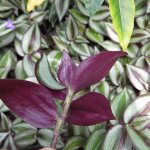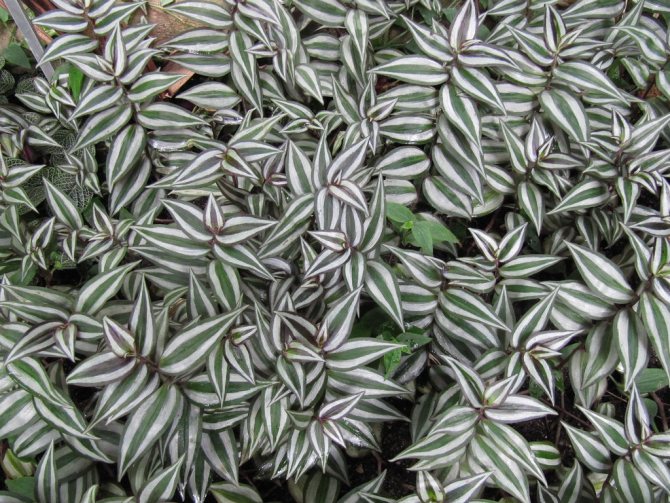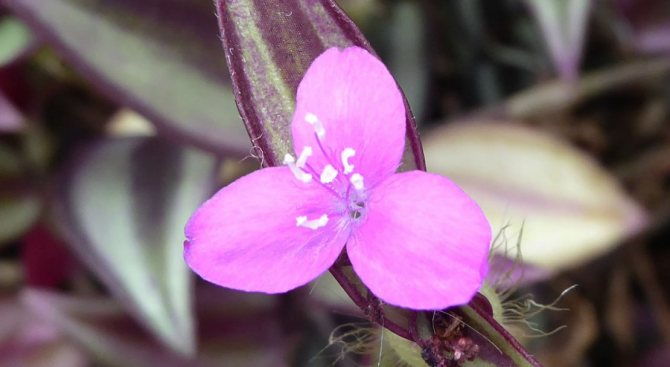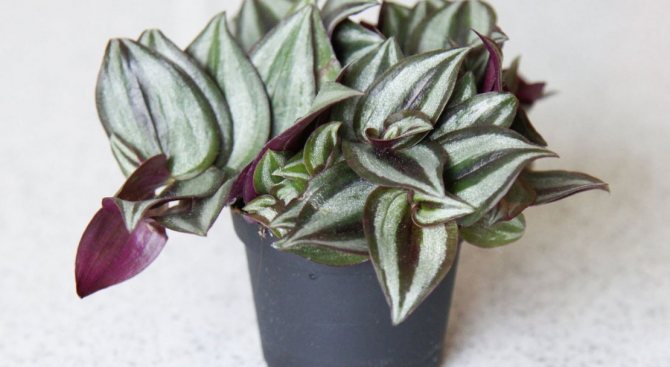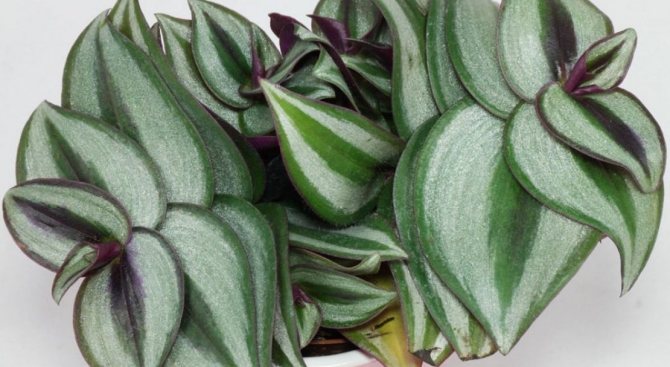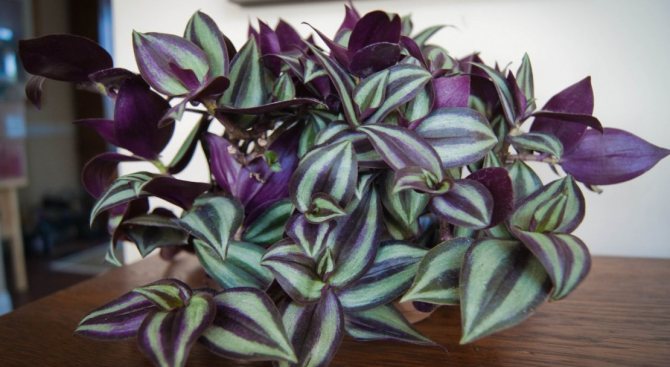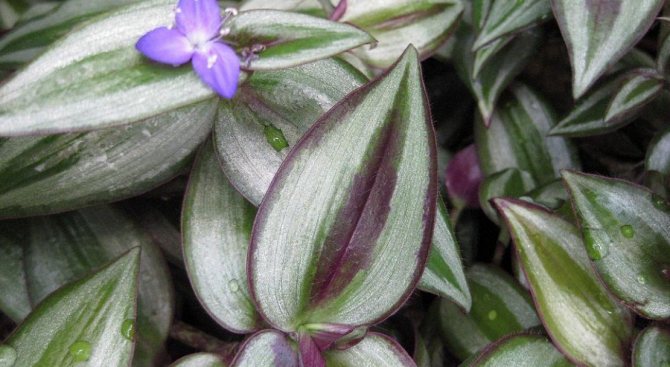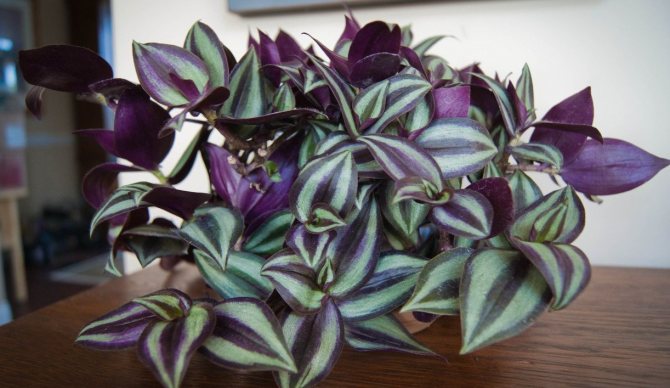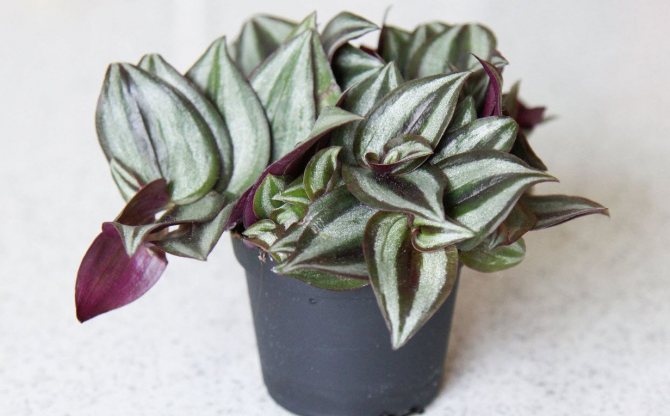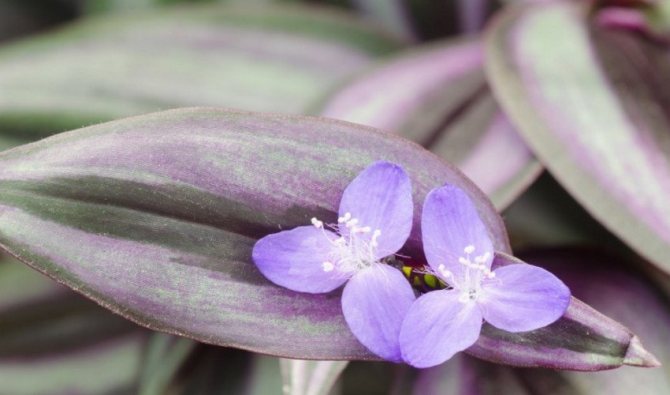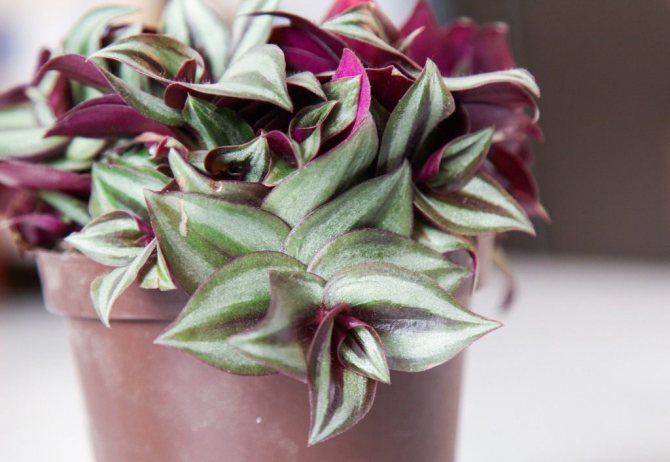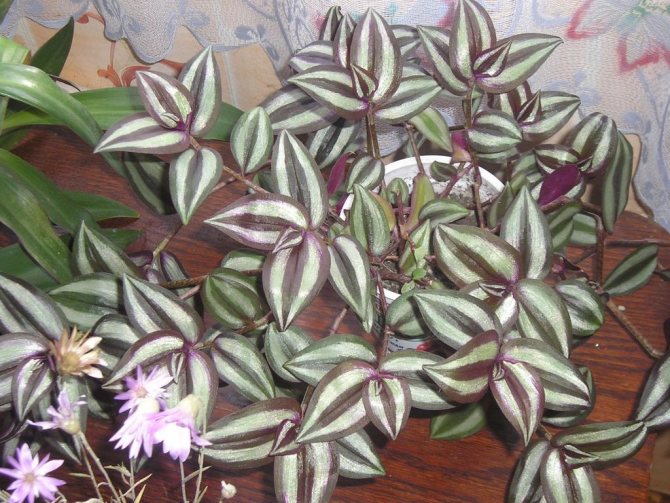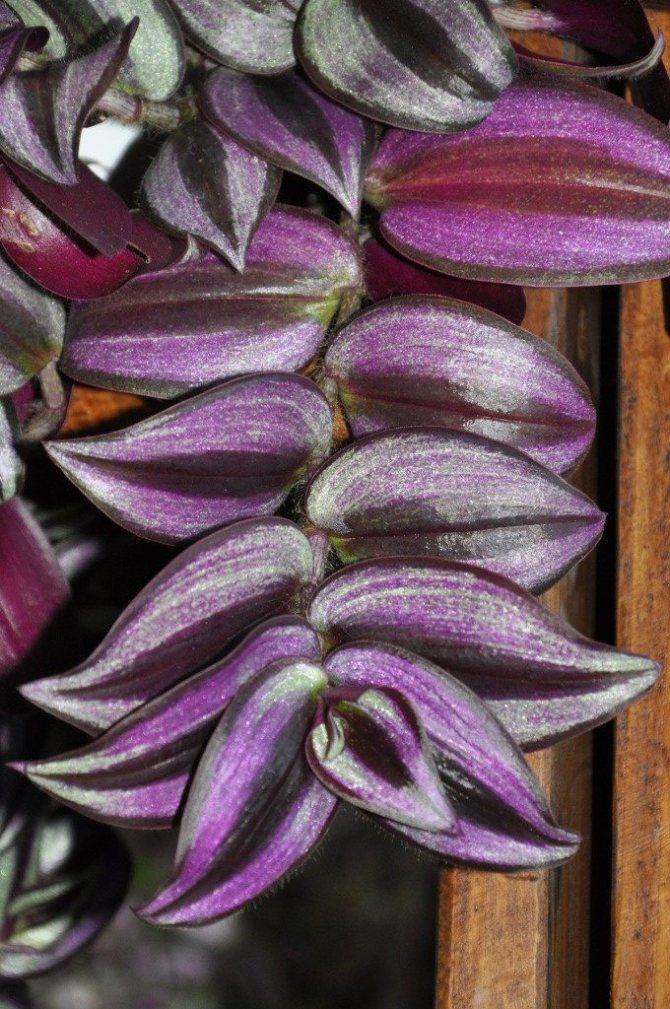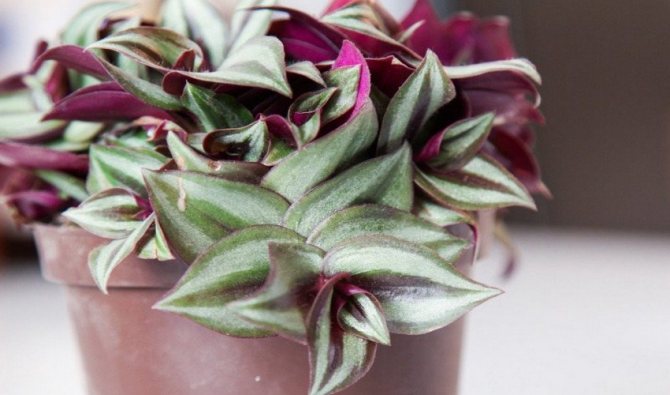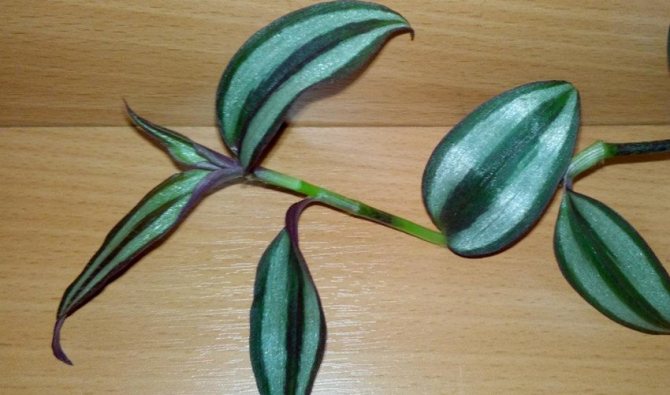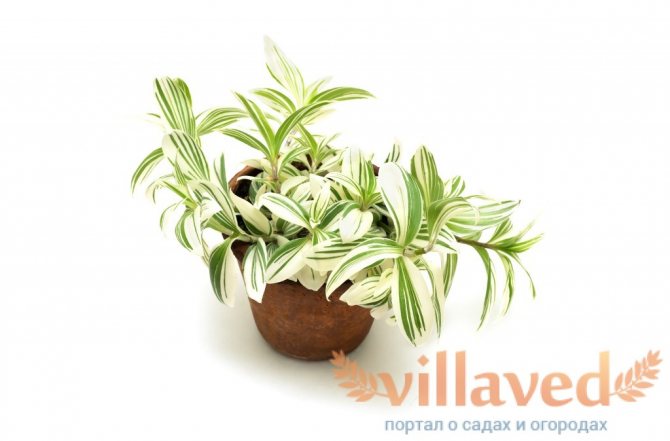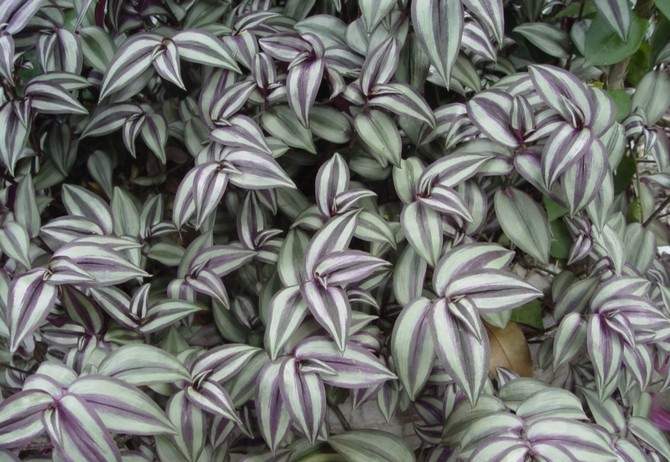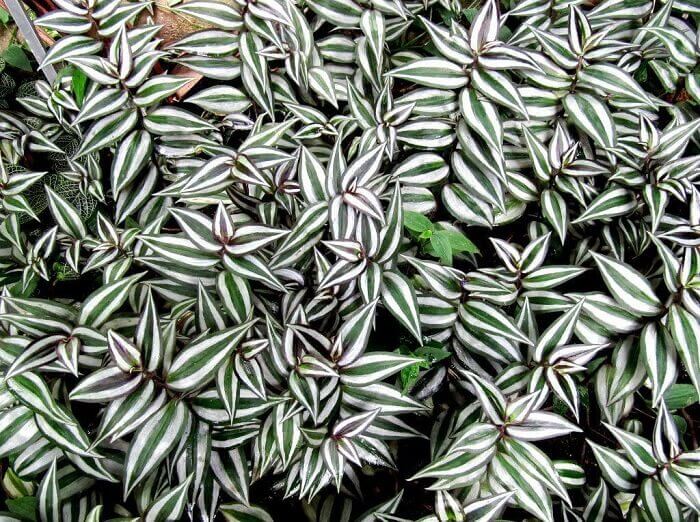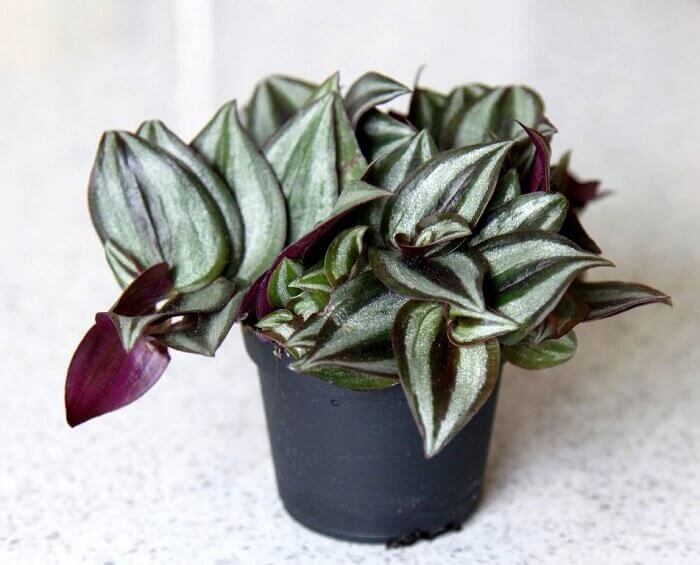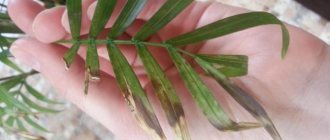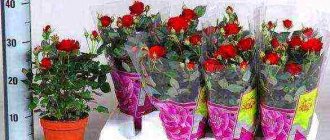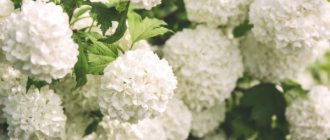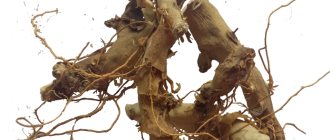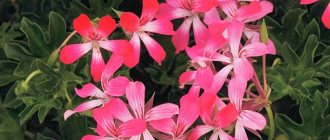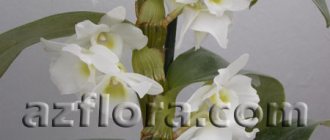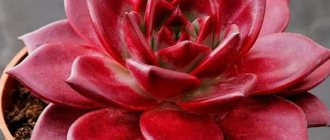Tradescantia zebrina or hanging (Tradescantia zebrina, formerly pendula) belongs to the family Commelinaceae (Commelinaceae).
This plant has a rich history of use in traditional medicine, and among Buddhists, Tradescantia Zebrin was generally cult in nature and was necessarily grown in every temple. In Latin Americans, crushed leaves were used to treat purulent wounds and bruises, freshly squeezed juice was drunk on a cube to relieve colitis, flatulence, and the treatment of cholera and other diseases of the gastrointestinal tract, and a little later, in Europe, zebrin juice was used to treat tuberculosis.
It should be noted that this value of zebrin was not taken from the air - many studies have shown that it contains a large number of useful microelements that have not only medicinal properties, but also the ability to cleanse the air in an apartment from pathogens.
therefore Tradescantia Zebrina will become not only beautiful ampelous decorative leafy addition to your apartment, but it will also bring enormous benefits to the atmosphere of your home.
Description of the plant
The Latin name for the flower is tradescantia zebrina. Commeline family.
A herbaceous evergreen perennial grows rapidly - the length of the stems can reach 1.8-2 m, the height is no more than 15 cm.
The leaves are sessile, oval with pointed tips, 7-10 cm long. The color is varied - the inner side is purple, the outer side is green with thick silvery and thin purple stripes.
The plant blooms with small three-petal inflorescences of pink, snow-white or purple tones.
The flowering period is in spring and summer.
Botanical characteristic
In the wild, it grows in tropical rainforests, along river banks and wetlands in Mexico, Central America, Colombia. Small plantations are found in South America, Africa, Asia and Australia.
Refers to herbaceous semi-succulents. In its natural environment, it grows up to 1.20 m. When grown at home, it has compact forms. With properly organized care, it intensively grows in the form of a lush creeping curtain.
Description:
- height varies from 15 to 60 cm;
- the stems are flexible, the growth is creeping, they have the ability to take root in the soil, there is no pubescence, the color is in shades of red and green;
- foliage up to 5 cm long, oval shape, pointed at the ends, variegated, pink-violet color, glossy surface with a characteristic shine, most varieties have silvery stripes on the sides, the underside is purple-violet,
- inflorescences umbellate, formed by small three-petal pink-purple flowers;
- the root system is formed by fibrous branches growing in breadth;
- fruits in the form of a tricuspid capsule, the number of seeds is more often 2 pcs.
Zebrina blooms when grown in open conditions from late spring to early summer. Indoors bloom lasts from September to February.
Varieties
Indoor Tradescantia has several ornamental varieties that are appreciated in home gardening.
- Hanging, or dangling (often called the "Wandering Jew"). The most popular type, it has healing properties.The leaves are large, ciliate, reddish-green with silvery longitudinal stripes. Below the leaf is purple-red.
- Red Hill. A beautiful plant with emerald leaves, bronze tint and gray stripes. Purple on the underside. This hybrid is grown in hanging pots, baskets. It belongs to the ground cover varieties, therefore it is suitable for growing in a flower garden.
- Setcreasea purpurea (Purpura, or purple heart). A lush plant with numerous stems, densely covered with dense leaves. The surface of the leaf plate is reddish-olive, contains slight pubescence, the underside is glabrous, purple.
- Flocculosis (flocculosa). Differs in white leaves with fine pile.
The healing properties of Zebrina Tradescantia
One cannot fail to mention the medicinal properties of zebrin. Traditional American healers put it on a par with the legendary aloe. Even their healing properties are similar: both are used to treat diabetes.
Zebrina has bactericidal properties. Tradescantia has been cultivated for medicinal purposes in Buddhist monasteries since ancient times. The leaves were crushed, the resulting gruel was applied to bruises, wounds, scratches, and even tumors were treated. Freshly prepared juice cleansed purulent wounds, relieved pain, it was taken for tuberculosis. On the island of Cuba, a decoction of the leaves was used for diseases of the digestive system.
Tradescantia is considered a natural air purifier, not inferior in this to chlorophytum, callisia and other plants.
The herbaceous plant is a real treat for pets. When they feel unwell, cats eat delicate leaves, which replace them with street medicinal grass in winter. They love to feast on them turtles, birds, hamsters and even fish.
Purchase and adaptation
You can buy striped Tradescantia in one of the flower shops. To get a strong and healthy plant, you need to carefully examine its aboveground part:
- leaves and stems of a rich color;
- there are no signs of infection with diseases and pests - yellow, black or red specks, growths;
- earthen lump without acidification and mold.
The condition of the root system is also important - through the drainage holes it will be possible to determine if the flower has health problems. In patients with Tradescantia, the roots are rotten, covered with mold, of an uneven tone with elements of black or white spots.
After purchase, the plant must be given time to adapt - it is quarantined for 20 days. During this time, he will get used to room conditions.
Planting and Care - Video

The homeland of the zebrina is the humid tropics, it was from there that it gradually crawled into human housing and won a special place not only on the windows, but also in the hearts of flower growers. This flower is not as simple as it might seem at first glance. At its core, Zebrina is a Tradescantia, while occupying a separate niche among indoor plants.
Zebrina, despite its belonging to Tradescantia, is very different from her. The first striking difference is, of course, the presence of charming stripes. Actually, thanks to them, the flower got its name. The second thing that distinguishes zebrina is the presence of a whole bunch of healing properties. Zebrina is a real indoor green doctor in a flower pot. She, along with such healers as aloe, Kalanchoe, golden mustache and geranium, helps with many ailments. In addition, it is a natural air purifier as well as chlorophytum, tradescantia, again geranium and spathiphyllum. Zebrin leaves have antibacterial properties, help with burns, are used in the treatment of stomach ulcers and have other properties.
Zebrina can be called a psychic in terms of choosing a place, her appearance will immediately show bad areas in the room, she will turn pale and wither.There is an opinion among the people that zebrina has the power to bring peace of mind to the house, improve relations with family and friends.
Zebrina is a real treat for younger brothers. Cats literally "graze" by the pots with this flower. Rodents, turtles and even poultry are very fond of zebrins. They probably know a lot about self-medication.
Landing rules
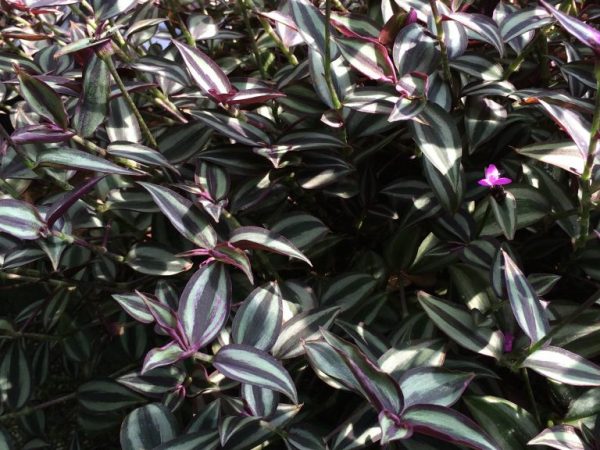

Planting a plant in spring
It is better to plant in the spring and before the new leaves begin to bloom. For planting, use a purchased substrate or prepared independently according to the above-described recipe.
The pot is taken from ceramics or plastic, at least 10 cm high, always with drainage holes at the bottom. A couple of handfuls of expanded clay are poured, then half filled with fertile soil. The roots are lowered, straightened, covered with earth to the top, lightly crushed around the stem, watered.
After planting, the flower is placed in a warm room with diffused daylight.
A transplant is necessary in the following cases:
- a purchased flower after three weeks of quarantine, since it will develop poorly in the store land;
- homemade tradescantia every three years so that they do not lack space and nutrients;
- in case of damage to the root system by rot, pests.
Before the procedure, the plant is watered abundantly, which makes it easier to extract the roots with minimal injury. Take a pot 2-3 cm in diameter larger than the previous one, fill it with drainage, fertile soil mixture. They transfer a lump with roots into a container, add the earth to the top, moisten it.
How to transplant after purchase
It is best to replant the flower only once a year, in the springtime. Transplanting into a large pot will give more room for the growth of the root system, but if it is not possible to transplant, Tradescantia will grow well in the same soil for several years.
For transplanting, ordinary meadow soil or birch soil is best suited, to which you can add a little well-rotted humus. Here is another successful composition of the soil mixture: two parts of leafy soil, to which one part of sod soil, humus and coarse white river sand are added. You can also purchase ready-made soil in the horticultural sector.
If Tradescantia was bought in the spring, but does not feel well, it may need to be transplanted into new soil or a larger pot. You can determine whether the pot is small for a plant by the roots that do not fit in the planting container. The volume of the pot should be such that the root system is located there freely, and there is 2-5 cm of free space between the roots and the wall of the container. This is necessary so that the flower can grow its root system for several years without hindrance, and receive enough nutrients from the soil.
Important! A plant purchased in the fall or winter, it is advisable not to disturb the transplant until spring.
How to transplant zebrin:
- A pot made of plastic, ceramic, glass or metal is suitable for tradescantia.
- The planting container must have holes for the drainage of excess moisture after watering.
- Before planting, drainage must be laid on the bottom of the planting tank, which will prevent moisture from stagnating in the roots, which can cause root rot. Drainage can be made from fragments of thick twigs, pieces of foam or expanded clay.
- In order to pull out an earthen lump with roots from a purchased pot: gently knock on the outer sides of the pot, then turn the flower over so that an earthen lump with roots protrudes into the grower's hands.
- Next, the root system is shaken off the old soil, and the roots are examined for rot. If there is one, the sore spot is carefully cut out with a garden pruner.
- A new pot is filled with soil by 1/3, after which the Tradescantia is placed in the center so that the root collar of the flower does not turn out to be deepened into the soil when planting, and is covered with earth.
- The planted flower is watered moderately so that the donkey soil. After that, if necessary, soil is poured into the pot of words. The soil level should end 1 cm below the edge of the planting container. This is important for the convenience of watering.
- The transplanted plant is set for 3-5 days in partial shade to provide it with gentle conditions for adaptation.
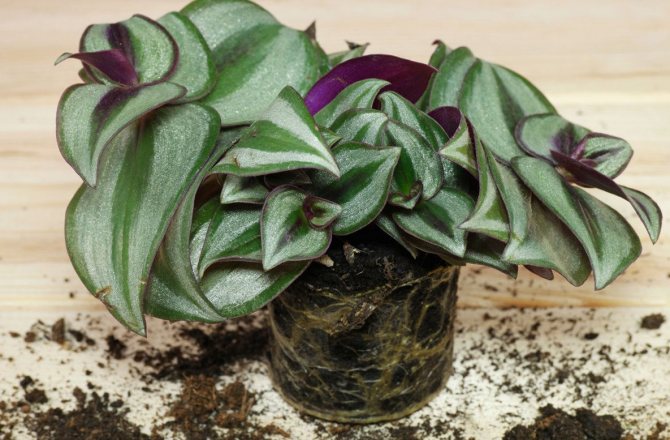

The necessary conditions
Variegated Tradescantia prefers to grow in a sunny location with diffused daylight protected from direct rays.
The best place would be a window sill on the west, southwest or east side.
When grown in the northern part of the house, the leaves turn pale and the flower itself develops slowly.
The soil is light and loose. You can use a commercially available decorative deciduous substrate or prepare your own soil mixture by mixing coarse sand with peat and perlite in a 1: 2: 1 ratio.
Microclimate
The duration of a light day is at least 10 hours. Diffused lighting. In winter, artificial lighting is required.
You can determine the lack of light by the faded foliage, which becomes monochromatic. Shoots also begin to stretch upward.
The flower can be kept at room temperature - 21-25 ° C.
He loves fresh air, but cannot stand drafts. Therefore, in autumn and winter, at the time of airing, it is transferred to another room.
Humidity should be moderate - about 65-70%.
- In the warm season, this condition is provided by frequent spraying of the crown - every 3-4 days.
- In winter, sprinkling is rarely carried out - once a month to wash off the dust from the leaves.
If it's too hot, you can put an open container of water next to the flowerpot, and also place the plant on a pallet with damp pebbles or expanded clay.
Zebrin flower application
Zebrins are magnificent ampelous plants. They work well both in hydroculture and on ion-exchange substrates.
Zebrin is used for wall decoration, as a substitute for a lawn in winter gardens, it is very beautiful in hanging vases filled with moss, peat, ion exchange substrate, etc. The use of the zebrin flower in a composition with tradescantia, netcreasia, bearded peperomia is popular. Grows under artificial light.
Zebrina as an ornamental plant has been well known for a very long time, but not many people know about its medicinal properties. And in vain, it has the most valuable pharmacological qualities. For a long time, official medicine did not want to admit this, despite the fact that back in the 30s the name of this plant appeared in the table created by the American Cancer Institute as having antitumor activity. Official recognition was brought to her by the research of Venezuelan biologist Jonathan Pirerro, during which he found out that its pharmaceutical properties can compete with such recognized authorities in the world of domestic medicinal plants as aloe and Kalanchoe.
In the sap of the plant, substances were found that significantly lower the amount of sugar in the blood, various phytoncides with antimicrobial and antiviral activity; in the case of zebrin, they are especially effective in the treatment of infectious diseases of the gastrointestinal tract. In ancient times, healers in Mexico, Venezuela and Cuba used zebrin as the first remedy for the treatment of colitis, dysentery, flatulence and other diseases of the gastrointestinal tract, which are very common and dangerous in warm tropical climates. The active substances of the plant are capable of killing not only pathogenic microflora, but also viruses.It is no coincidence that cats and dogs are so happy to eat the shoots of zebrin and tradescantia: they use them as a prophylactic agent to stabilize the digestive tract. Of course, they don't know about it, but you and I know that animals are much "smarter" than us when it comes to using medicinal plants, because they are born with this knowledge.
The people of Mexico and Venezuela used crushed zebrin leaves in ancient times to treat corns, bruises and cuts. A decoction of the leaves was used in the treatment of colds, coughs, dysentery, diarrhea. There is information about the use of plant sap for the treatment of tuberculosis and periodontal disease.
This plant belongs to a separate species and is considered an independent plant. Despite the fact that it is inherently Tradiscantia, it takes its definite place among indoor plants. At the same time, zebrina is very different from many Tradiscans. Firstly, by its colors, as a result of which it got its name. But not everyone knows that this plant has a whole range of unique healing properties. If you list a number of diseases that can be cured by zebrin, this will be a huge list, which includes diseases such as cholera. At the same time, it helps to get rid of burns.
It has the natural properties of an air purifier, like the entire family of Tradiscantia, including spathiphyllum, chlorophytum, etc. Thanks to her abilities, she can successfully replace her other relative - Callisia, or rather, its kind of Golden Mustache. Its antibacterial properties and the ability to heal wounds put it next to well-known plants such as Kalanchoe and aloe.
Among other things, this plant is simply adored by pets, especially cats, who see in it a substitute for those herbs that they find on the street if they feel bad. It is quite possible that if there is a cat in the house, then he will definitely graze on it. At the same time, not only cats love her, but also birds, turtles, etc.
Care features
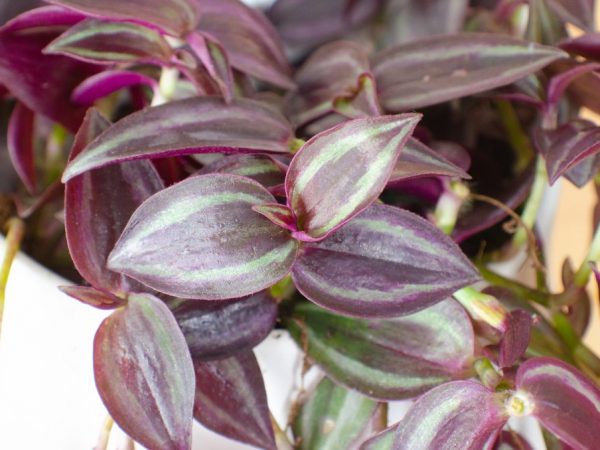

You need to monitor regular watering
Proper home care will help you achieve maximum decorative effect from this plant.
Watering
You need to moisten the flower regularly, its further growth depends on it.
The frequency of watering is adjusted according to the season:
- in spring and summer - every 3-4 days;
- in winter - every 7 days.
At the same time, it is important that the surface layer of the soil dries out, since frequent waterlogging can cause the development of root rot.
After each watering, light loosening of the soil is carried out to ensure full access of oxygen and moisture to the roots.
Pruning
The creeping plant does not need to form a crown, therefore, only a sanitary haircut is carried out every spring.
All stems and leaves that have dried or turned yellow must be removed, since they are a source of infections and a good environment for pests to appear.
For trimming, a sharp and sterile instrument is taken to prevent infection.
Home care
Taking care of a zebra is easy. Even an inexperienced grower can grow this representative of the flora.
Selection of soil and location
The plant is quite light-requiring. The ideal place for its growth will be windows facing east or west. The brightness of the color is best manifested in diffused light.
Zebrina is a psychic in terms of the place of growth. A bad area in the room will affect the appearance of the tradescantia: the plant becomes pale and stunted.
There is a sign among the people that a good family atmosphere, comfort and tranquility reigns in the house where the zebrin grows.
For a herbaceous perennial, the soil mixture should be prepared in the following ratio: leaf soil (2 parts), one part each - humus, sand and sod soil.You can use a commercial soil substrate for variegated plants, diluting it with sand - a quarter of the required soil volume.
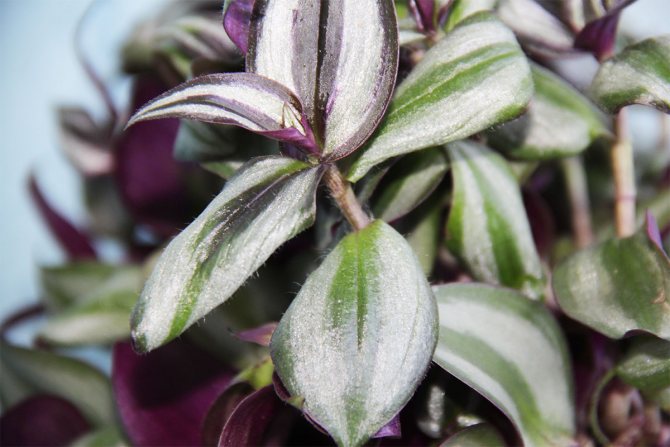

Fertilizers and feeding
Top dressing must begin in the spring, at a time when Tradescantia begins to grow actively. Complex fertilizers must be applied once every two weeks. In the autumn-winter season, you do not need to feed the flower. Fertilizer should not be applied immediately after transplanting or if the plant is "sick".
When using organic matter, you need to know when to stop: an excess of humus will lead to the loss of the "striped" color.


Landing
It is better to choose a pot for planting a plant wide, but shallow, since the root system of the tradescantia is located at the surface. The container must necessarily have drainage holes. The best option is a ceramic pot that allows air and water to pass through. Plastic pots do not have these qualities, so you need to loosen the soil in them much more often.
Pour expanded clay at the bottom of the pot, small pebbles or polystyrene can be used to prevent moisture stagnation. Fill in the prepared soil mixture, moisten it.
Cut shoots are good planting material. Vertices take root quickly. It is recommended to plant 5 - 7 cuttings in one pot at once, so that the plant will further bush. Cover the planted cuttings with a transparent bag. With this greenhouse effect, the planting material will take root faster. You can not cover the plant, but simply shade.
Temperature
Tradescantia Zebrina feels comfortable at any room temperature. There is no need to underestimate it in winter: the plant has no dormant period.
In spring and summer, the perennial grows actively, the stems drop and hang down. Many growers use hanging pots for growing. The temperature in summer is favorable in the range from +17 to +25 degrees, but a higher temperature is not critical for a flower.
In winter, with a decrease in daylight hours, you can move the plant to a cooler room to stop growth and extension of shoots. In this case, the zebrina will retain its decorative appearance.
Illumination
The ampel flower tolerates both shade and bright sunlight favorably. The color of the foliage will depend on the amount of light: when shaded, the leaves become saturated green, in diffused sunlight, the contrast of the stripes appears much brighter. You can grow Tradescantia under artificial lighting.
Watering
It is better not to overdry the soil in a pot and not overfill. Overdrying of the soil leads to damage to the weak root system of the flower, and overflow leads to rotting not only of the roots, but also of the stems. The soil substrate must be constantly moderately moist.
The need for watering can be judged by the top layer of the earth: if it is two centimeters dry, then the Tradescantia needs to be watered. The frequency of watering will also depend on the season - more often and more abundantly in summer, less often in winter.
Air humidity does not play a big role in the development of the plant. But Zebrin will not refuse a warm shower and spraying.


Transfer
After buying a tradescantia in a store, the plant from a cramped container must be transplanted into a more spacious one. The new pot should be two or three centimeters freer than the previous one. Use the soil as for planting: ready-made purchased or prepare yourself. Cover the bottom of the planting container with a hole with a drainage layer.
Zebrina loves a transplant. Young bushes need to be replanted in spring every year, adults - every 2-3 years. This should be done in a transshipment way so as not to injure the roots.
The plant grows quickly, losing its attractiveness over time: the shoots at the base are bare, and the branches are stretched out. It can be rejuvenated by pruning or re-grown from cut cuttings.
Zebrina needs pruning and tolerates well. If this procedure is carried out regularly, the plant will not lose its decorative effect for a long time.Pinching the tips of the shoots stimulates branching, making the flower compact. Old unattractive shoots are cut off, young ones grow quickly and even bloom. Pruned shoots can be used as planting material.
Reproduction methods
Indoor Tradescantia Zebrin can be multiplied by several methods, which one to choose is up to you.
Cuttings
Cuttings are cut during spring pruning - they take strong and healthy shoots from an adult plant. The optimal length is 10-12 cm.
For quick rooting, they are dipped into a vessel with water with the addition of Epin. Keep in such an environment until roots appear on the cuttings. This usually takes 2-2.5 weeks.
Rooted seedlings are planted in the same substrate as adult specimens. For planting, take plastic containers or seedling boxes. They are planted to a depth of 3-4 cm at an angle, watered. They create a greenhouse effect by covering the seedlings with transparent film or glass.
Every day they are ventilated, if necessary, irrigated from a spray bottle. As soon as new leaves appear on them, the shelter can be removed. The grown flowers are planted separately in flowerpots.
Dividing the bush
Usually, this method is used when you need to transplant and rejuvenate an old plant. It is abundantly moistened after an hour, when the earth is soaked, remove and lower the lump with roots into a basin of water.
After the remnants of the soil are washed off, the root system is taken out, dried, all dubious roots are removed, then the plant is divided into parts so that each has one shoot and 2-3 root processes. Places of cuts are covered with charcoal.
Seated in separate pots, watered.
Seeds
This method of reproduction is rarely successful, moreover, it is a laborious process and requires a lot of patience.
This plant has very small seeds, so they are sown in a seedling box or container with compacted soil. Lay out on the surface of the soil, then sprinkle with a thin layer of a mixture of peat and sand (1: 1). Cover with transparent glass, ventilate for half an hour every day, irrigate after 2 days from a spray bottle.
In about a month, sprouts should appear, then the glass is removed, and the seedlings are placed in a warm place with diffused daylight. Grow until they release one pair of leaves. Then they are seated one by one in pots.
Zebrina varieties: hanging and purple
ZEBRINA VISYACHAYA (Zebrina pendula Schnizl.). Commeline family. Homeland - tropical Mexico. Perennial herb with hanging, easily rooting shoots.
As you can see in the photo, this species of zebrin has bare stems, alternate leaves, green above with two bright silvery stripes along the main vein, purple-pink below:
A very common plant in indoor culture called tradescantia zebrina. Care and breeding methods are the same as those of Purpuz's zebrin.
Good for wall decoration, room decoration, etc. It is used in the same way as Purpuza Zebrina.
ZEBRINA PURPUZA (Zebrina purpusii Brukner). Commeline family. Homeland - tropical, humid forests of Mexico. Perennial herb, similar to Tradescantia. Stems are recumbent, herbaceous, slightly pubescent. The leaves are stalk-enveloping, alternate, medium-sized, broadly ovate, slightly pointed at the top. Above, the leaf blades are somewhat pubescent, the underside is glabrous. Above, the leaves are purple-lilac, below with a reddish-purple tint. Depending on the intensity of light, the color changes: in the shade it is dull green-olive, almost without a red tint, in a sunny place it is intensely purple-olive. The flowers are medium-sized, lilac.
Zebrina Purpuza is a fast-growing and undemanding plant. Grows in different light conditions.It reproduces very easily by herbaceous cuttings with 2-3 nodes in different substrates. You can plant several cuttings at once in pots, boxes, micro-greenhouses, grow in moss or peat. Watering in winter is needed more moderate than in spring and summer. Zebrins are disease resistant.
The earthen mixture can be different, for example, from leafy, humus, sod land in equal parts and sand. Fertilize in the spring, applying phosphorus, nitrogen and potash fertilizers. With aging, the plants should either be rejuvenated by cutting off the elongated shoots, or young cuttings should be planted again, replacing the old soil. Care is normal.
Diseases and pests
In the process of cultivation, the culture can suffer from the invasion of various parasites and become infected with fungal infections. With timely identification and treatment, you can save her.
| Diseases and pests | Symptoms | Treatment methods | Prevention |
| Spider mite | A microscopic insect braids a small cobweb of internodes, the underside of leaves, feeds on their sap. The lesions turn yellow and dry out. Appears in a room with high temperature and low humidity | Acaricides are used to fight - Actellik or Aktara. In isolated cases of infection, the crown is irrigated with a concentrated soap solution | Adjust temperature and humidity |
| Shield, false shield | Small red insects in the form of plaques stick to the surface of all organs, feed on their juice. The affected areas acquire a reddish or brown color, over time, the plant completely withers | You can destroy the pest as follows: remove the insects with a cotton swab dipped in a solution of laundry soap. Then carry out a double treatment with Decis with an interval of 7 days | Regularly inspect for lesions (once every 2 weeks), remove yellowed, rotten stems, leaves, use a sterile substrate for planting and transplanting flowers |
| Mealybug | Appears on flowers that suffer from excess moisture or frequent crown irrigation. You can identify them by the white cotton bloom - this is the excrement of the parasite. Under the sticky substance, the tissues begin to turn yellow, brown and rot | The plant is removed from the pot, the roots are washed to wash off the remaining soil, and immersed in a fungicide solution for an hour. Additionally, all damaged fragments on the stems are cut out, irrigated with insecticides (Fundazol, Fitoverm or Karate) | Buy healthy flowers, transplant them into a pre-disinfected soil mixture. |
| Root rot | Fungal disease, appears with frequent overflow. The root system rots, after which it begins to fade, the stem turns black, the leaves turn yellow, crumble | The flower is removed from an old container, dipped into a vessel with water, the roots are washed, dried, all rotten roots are cut out, treated with fungicides, dried. Transplanted into a new pot with sterile substrate | Avoid waterlogging |
Other health problems of the flower can also lead to loss of decorativeness and further death:
- yellowing and massive foliage is a sign of a lack of moisture, light or nutrients;
- leaves curl, then dry - the air in the room is too dry;
- stems and leaves wither from drying out of the substrate;
- foliage turns pale and takes on a monochromatic color - the plant suffers from a lack of light;
- bare stems do not develop new leaves - this usually happens in old specimens that need to be rejuvenated by dividing and planting in pots with fresh and fertile soil;
- leaves wrinkle, turn brown - a sign of low humidity or poor lighting.
Growing problems:
- Yellow spots on the leaves appear when there is a lack of moisture in the soil;
- Sluggish shoots - insufficient watering;
- In a variegated variety, color is lost if the plant does not have enough light intensity;
- Lack of growth, shoots stretch out, leaves thin out with a lack of water, fertilizers, light;
- The tips of the leaves turn brown if the humidity in the room is too low;
- Leaves dry, fall off at the base of the stem - the plant should be rejuvenated.
Views: 33
Botanical description
Zebrina is a tropical perennial flowering plant of the Orchid family. In the description of botanical communities, the official name is Phalaenopsis zebrina. The most widespread are the forests of Burma, Mexico and Malaysia.
The branching type is monopodial. The flowering period in the wild is from early spring to late summer. In an artificial environment, flowering is extremely rare. The length of the oval pointed leaf plate of individual specimens reaches 25 cm, the width is 7 cm.
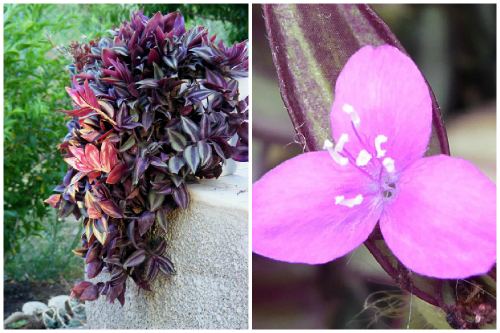

Zebrina juice is identical in composition and properties to aloe and Kalanchoe juice. Due to the high content of phytoncides, it has immunomodulatory, wound healing, antibacterial properties. It is actively used in folk medicine as a medicine in the fight against various diseases. In addition, studies have shown the plant's ability to absorb electromagnetic waves.
Zebrina is a real healer
Zebrina is a medicinal plant, it was established in ancient times by Buddhist monks. The juice contained in the leaves and shoots has:
- lowers blood sugar levels;
- has anti-inflammatory and antimicrobial effects;
- stops blood;
- promotes rapid healing of small wounds.
The amazingness of the Zebrin plant is not only in decorativeness, but also in unique properties that help get rid of ailments. Another useful property is the ability to purify the air. That is why the flower is often grown in the kitchen, placed next to the computer. Zebrin is widely used in hospitals, schools.
It is not difficult to grow a flower of Health, there would be a desire.
Zebrina reproduction
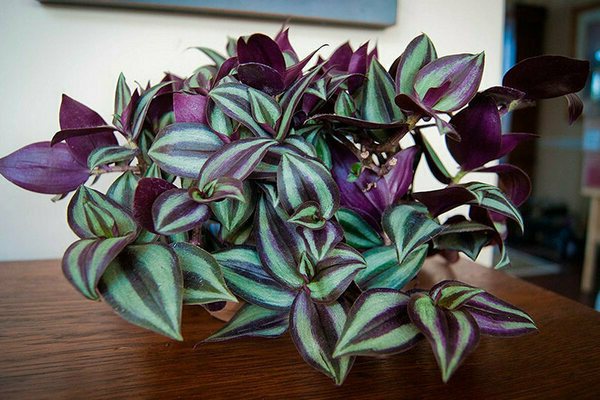

This culture multiplies very simply. This process can be done all year long with cuttings. The breeding rules here are similar to the breeding technology of Tradescantia, as well as ivy, stephanotis and other plants.
The cuttings must be rooted in the ground, it is possible in the sand, but the easiest way to do this will be in a glass of water. Experienced growers recommend placing the cutting directly into the soil. For this, a small box is suitable, in which several seedlings are planted at once along the edge of the container walls. After some time, the cuttings will root quite well, and it will be possible to transplant them into separate containers.
Description


Zebrina is often grown in hanging pots.
Tradescantia zebrina is a herbaceous plant of the Kommelin family. It has an unusual leaf color. On the lower side, they are painted in a purple shade, on the upper side, they are two-colored. A green-purple stripe runs along the central vein of the leaf, wide silvery stripes on the sides of it. The center and edges of the sheet are purplish green.
Shoots of young plants are erect, and with age they go down. They reach 80 cm in length. The stems of cylindrical cross-section also have a violet-purple hue. The alternate leaves are rounded at the base, oval in shape. They reach 7 cm in length and 3 cm in width. At home, zebrin rarely blooms, although it is valued mainly for its beautiful leaves.
Origin story
In the distant seventeenth century, the English king Charles the First served as chief gardener John Tradescan, also a research scientist and traveler. At that time, the recently discovered continent of America was actively studied, and a huge number of plants unknown in Europe required classification and naming.
Among this variety, John's attention was drawn to a nondescript, creeping plant from the rainforest. It did not have beautiful flowers, but it was distinguished by its unpretentiousness and rapid growth.
Tradescan realized that this plant had wonderful prospects and seriously approached its cultivation and cultivation.
Among the many indoor plants, few people will not recognize this plant and will not call it by name, remembering it at the same time - gardener Tradescan.
Plant photos
Photo
Transplant and reproduction rules
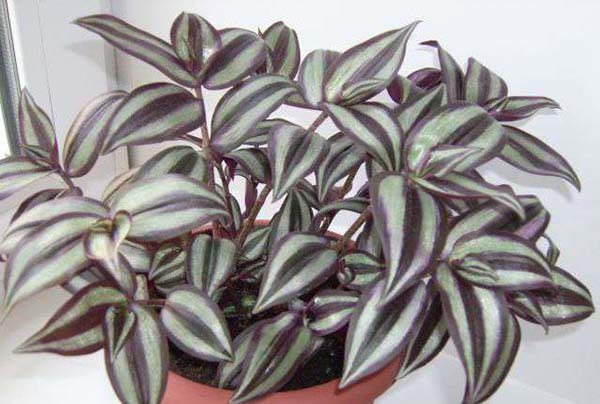

It is often not necessary to transplant zebrin if it is renewed every year. From time to time, they cut out the bald whips, remove the yellowed leaves. This way the beautiful appearance is preserved.
When transplanting, a plant with a lump of earth is transferred into a slightly larger pot so as not to disturb the root system. So that the earth does not get on the shoots, and they are not damaged, you need to wrap it with a piece of cloth.
Zebrina propagates by shoots. They can be rooted in water or directly in the ground.
In more detail Reproduction of indoor plants is an amazing activity
Reproduction of miscanthus
The plant requires a mandatory transplant, as its leaves turn yellow and wither with the onset of cold weather. Transplanting is best done by dividing the bush. Although the procedure is easy, it is quite traumatic for the bush.
This is done with a sharp knife, the roots are laid on a hard surface and carefully cut. After dividing, you can start planting your plant. Having previously made a hole and sprinkled it with fertilizer from cow dung. As the plant is transplanted, it must be watered abundantly with water. Please note that miscanthus does not like transplants, so this should be done with caution and not too often.
Origin and description
The plant belongs to the genus Tradescantia and the Commeline family, its closest relative is the golden mustache. Zebrina is an inhabitant of the humid tropics with many medicinal properties and amazingly beautiful hanging shoots with thick and bright foliage. The ampel got its name just for the color of the sheet plates.
Zebrin Tradescantia - external signs:
- the stem is long, smooth and dense to the touch, has a cylindrical section;
- shoots are creeping, branched and falling, stretching up to 1 meter in length;
- leaves are oval in shape, with a pointed end and alternate;
- leaf color: the underside is bright purple, the outside is separated by stripes of different shades - from dark green to deep crimson;
- the root system is superficial, it penetrates the soil shallowly.
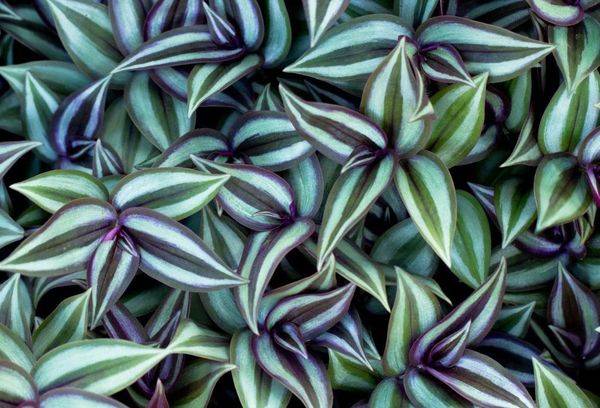

In the wild, zebrin produces small lilac or pink flower stalks in spring. But in the home, it rarely blooms. After 5-7 years, the flower loses its external attractiveness and beauty, with the help of stem cuttings it is re-grown.
Indoor Tradescantia purifies the air and saturates it with phytoncides. Its foliage has a bactericidal and disinfectant effect. This flower creates a favorable atmosphere in the house. This plant is always enjoyed by pets.
Zebrina landing


Zebrina looks beautiful and performs its decorative functions during the first three years of life. Then the plant already has a completely unattractive appearance, and, as a rule, it is replaced by a younger plant. Therefore, no one is engaged in transplanting a bush. You can only dwell on the landing rules in more detail.
For this plant, the optimal composition will be soil containing leafy soil, turf soil in equal proportions, as well as 1 part of sand.
Propagation by cuttings
The breeding process for Tradescantia is very simple and consists of just a few steps:
- To begin with, pinch the stem (10-15 cm high) above the leaf or at the site of internode formation.
- Then it is left in a container with water until roots appear (this usually takes 7-10 days).
- After that, the young shoot can already be planted in a separate pot, covering it with foil for the first time in order to create a suitable microclimate (+ 15… + 18 ºС).
Just do not expect that the sprout will immediately start active growth: sometimes it may take a seedling about a month to take root in a new place.
Important! Spring-summer is considered the best period for the separation of a new plant - it is at this time that the best conditions for its growth.
Flowering period
Tradescantia Zebrina blooms with small pink or purple flowers, although this rarely happens at home. They are radially symmetrical, with three lobes. The calyx and corolla of the Tradescantia are spiny-leaved. Flowers open in spring-summer at the top of the stem, leaf axils. The flowering period does not provoke the development of an allergic reaction.


Zebrina bloom.
Transfer
Due to the active growth, this species of bindweed regularly needs replanting. There are no specific terms for this, you just have to monitor the state of the plant itself. And as soon as you understand that there is no longer enough space in the pot, then you need to carry out a transplant.
To do this, find a new suitable flowerpot. It should be short, but wide, so that there is enough space for the grown zebrin, otherwise its development will stop. But remember that too much capacity can provoke a problem and lead to acidification of the soil. And be sure to take care of the presence of drainage in the pot.
As for the soil itself, it is worth choosing nutritious and loose soil.
Peat substrates are usually bought for transplants, but many amateurs make suitable soil on their own, using in a 2: 1: 1 ratio:
- garden soil (neutral or slightly acidic);
- humus;
- peat.
Did you know? According to the teachings of Feng Shui, indoor tradescanning removes electromagnetic radiation from the room and improves the overall climate in the house.
If desired, the mixture can be supplemented with a small amount of river sand.


Reproduction
Zebrina reproduces in the easiest way, namely vegetatively. It will be enough to choose strong cuttings, cut them and plant them in a pot along the walls. The number of cuttings is 5-6. It is better to give preference to a low pot with a wide bottom. Next comes, short in time, the process of rooting cuttings.
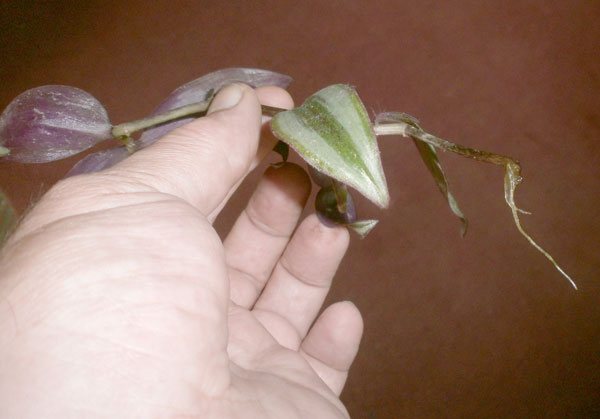

After that, it remains only to plant the cuttings, you can in the ground, or you can try the hydroponics method. An alternative would be to plant it in water, so the plant will reproduce all year round. The grown stems can reach a length of 180 centimeters. Over time, the first open buds will appear, they usually have a purple or pink color and a small size.
Due to the rapid aging of the plant, it must be pruned very often. It is these cuttings that can be used for planting. Choose areas that are about 5-8 centimeters long.
Breeding zebrins
This plant is easily propagated by cuttings. The apical parts of the shoots with 3 - 4 leaves are taken on the cuttings, which are simply dropped into the prepared soil and watered regularly. Covering with a transparent bag or using mini greenhouses is optional. Rooting takes place and so, and in just a week.
To get a more lush bush, it is advisable to plant several branches at once in one pot.


Zebrin transplant
As such, a zebrin transplant is not particularly needed. The decorative age of the plant is very short. Even if you make every effort, follow all the rules of care, create ideal conditions for the plant, all the same, after three years the shoots will bare, and it will become completely unattractive. More often, growers grow a new plant every year. Labor costs are minimal, and the effect is higher. But if you have grown a beautiful plant, and you are sorry to part with it, then you can transplant it. The land for the transplant is the same as for the Tradescantia. Yes, and preparing it yourself will not be difficult. You just need to mix two parts of leaf and sod land with one part of sand.
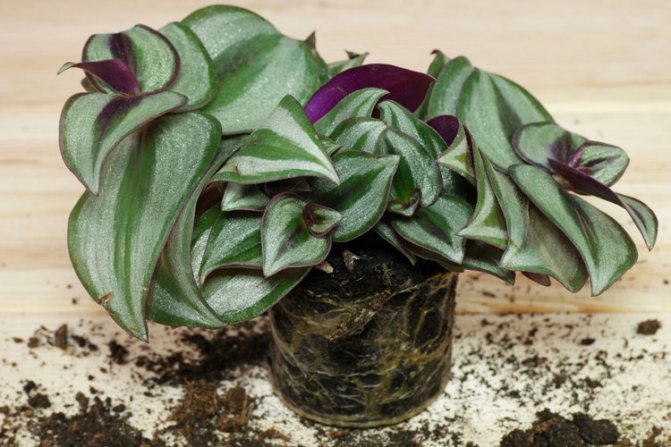

Zebrina care rules
Hanging Zebrina (the second name of the flower) is an unpretentious plant. Care rules are reduced to compliance with four prerequisites.
Lighting. Variegated Tradescantia is absolutely not demanding in light. The flowerpot can be placed anywhere in the room. In summer, it is allowed to land in open ground. The only requirement for the location is the absence of direct sunlight.
Air temperature. Zebrina is actively developing in temperature ranges from + 15 ° to + 26 °. Exceeding the indicators leads to a halt in growth and provokes various diseases.


The soil is preferable light, slightly acidic. The composition should include:
- sod land;
- humus;
- leafy ground;
- river sand of a coarse fraction.
Watering in the summer months - 3 times a week. In winter, the amount of watering is reduced to a minimum. The topsoil serves as a reference point.
Zebrina purple comes from the tropics. Therefore, the moisture level should be maintained by regular spraying. This is especially true for the heating season, when the air in the apartments becomes too dry.

